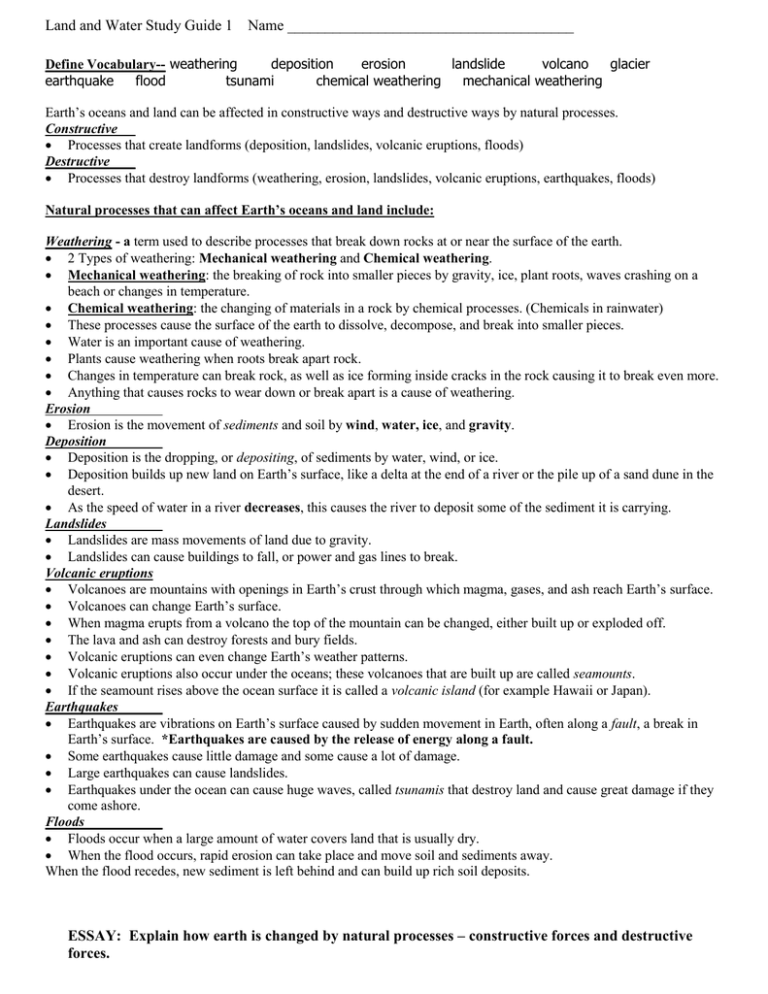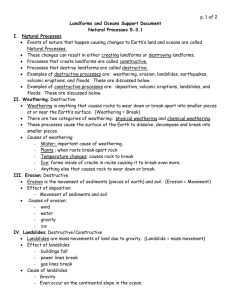Land and Water Study Guide 1 Name Define Vocabulary
advertisement

Land and Water Study Guide 1 Name ______________________________________ Define Vocabulary-- weathering deposition erosion landslide volcano glacier earthquake flood tsunami chemical weathering mechanical weathering Earth’s oceans and land can be affected in constructive ways and destructive ways by natural processes. Constructive Processes that create landforms (deposition, landslides, volcanic eruptions, floods) Destructive Processes that destroy landforms (weathering, erosion, landslides, volcanic eruptions, earthquakes, floods) Natural processes that can affect Earth’s oceans and land include: Weathering - a term used to describe processes that break down rocks at or near the surface of the earth. 2 Types of weathering: Mechanical weathering and Chemical weathering. Mechanical weathering: the breaking of rock into smaller pieces by gravity, ice, plant roots, waves crashing on a beach or changes in temperature. Chemical weathering: the changing of materials in a rock by chemical processes. (Chemicals in rainwater) These processes cause the surface of the earth to dissolve, decompose, and break into smaller pieces. Water is an important cause of weathering. Plants cause weathering when roots break apart rock. Changes in temperature can break rock, as well as ice forming inside cracks in the rock causing it to break even more. Anything that causes rocks to wear down or break apart is a cause of weathering. Erosion Erosion is the movement of sediments and soil by wind, water, ice, and gravity. Deposition Deposition is the dropping, or depositing, of sediments by water, wind, or ice. Deposition builds up new land on Earth’s surface, like a delta at the end of a river or the pile up of a sand dune in the desert. As the speed of water in a river decreases, this causes the river to deposit some of the sediment it is carrying. Landslides Landslides are mass movements of land due to gravity. Landslides can cause buildings to fall, or power and gas lines to break. Volcanic eruptions Volcanoes are mountains with openings in Earth’s crust through which magma, gases, and ash reach Earth’s surface. Volcanoes can change Earth’s surface. When magma erupts from a volcano the top of the mountain can be changed, either built up or exploded off. The lava and ash can destroy forests and bury fields. Volcanic eruptions can even change Earth’s weather patterns. Volcanic eruptions also occur under the oceans; these volcanoes that are built up are called seamounts. If the seamount rises above the ocean surface it is called a volcanic island (for example Hawaii or Japan). Earthquakes Earthquakes are vibrations on Earth’s surface caused by sudden movement in Earth, often along a fault, a break in Earth’s surface. *Earthquakes are caused by the release of energy along a fault. Some earthquakes cause little damage and some cause a lot of damage. Large earthquakes can cause landslides. Earthquakes under the ocean can cause huge waves, called tsunamis that destroy land and cause great damage if they come ashore. Floods Floods occur when a large amount of water covers land that is usually dry. When the flood occurs, rapid erosion can take place and move soil and sediments away. When the flood recedes, new sediment is left behind and can build up rich soil deposits. ESSAY: Explain how earth is changed by natural processes – constructive forces and destructive forces.






